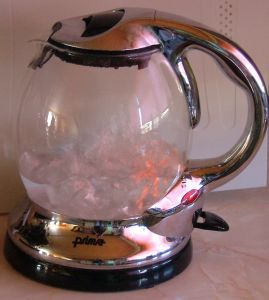Question for Thought
When water absorbs heat, what will happen?
The previous question may seem very simple – but the answer is not straight-forward. If you add heat to liquid water, the temperature of the water should increase; but you have also learned that, by absorbing energy, liquid water can vaporize. So, if water absorbs heat, which outcome occurs?
Whether water will increase in temperature or vaporize when it absorbs heat depends on the water’s initial temperature. If the temperature of a sample of water is below its boiling temperature (100 °C at 1 atmosphere of pressure), adding heat to the sample will simply cause the temperature to increase. However, if the sample of water is already at its boiling temperature, adding heat will result in vaporization; the water will turn into water vapor (steam).

Interestingly, when heat is added to a sample of water, the temperature of the water may increase or the water may boil, but the water cannot do both at the same time. If the water’s temperature is increasing, it is not boiling; if the water is boiling, its temperature is not increasing. Can you explain why this is the case?
Your Turn
Explain why the temperature of a substance does not increase while it vaporizes, even though the substance is absorbing heat.
When a substance is vaporizing, the thermal energy that is absorbed allows the intermolecular bonds of a substance to separate, working against the attractive intermolecular forces within the substance. Then, the absorbed heat does not cause the kinetic energy of the particles to increase. In essence, the absorbed heat is “used” to overcome the intermolecular forces and separate the particles, rather than to increase the kinetic energy of the particles. Because the average kinetic energy of the substance’s particles does not change, the temperature of the substance remains constant.